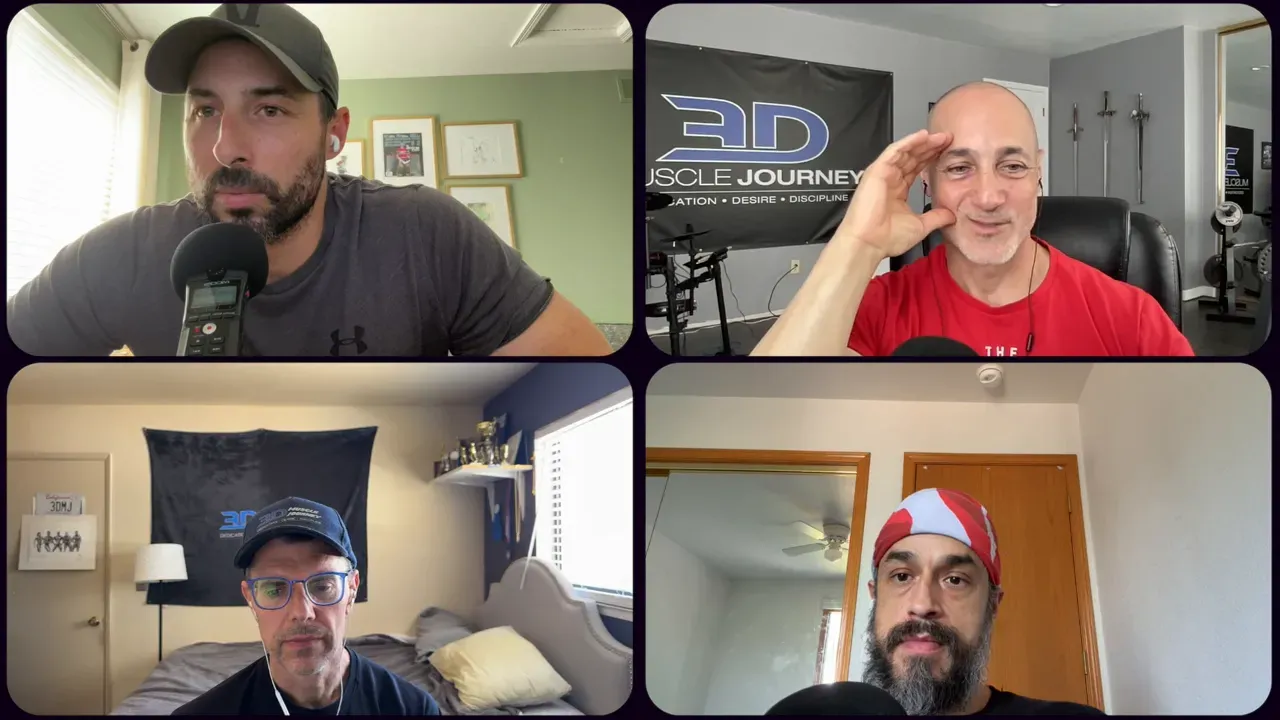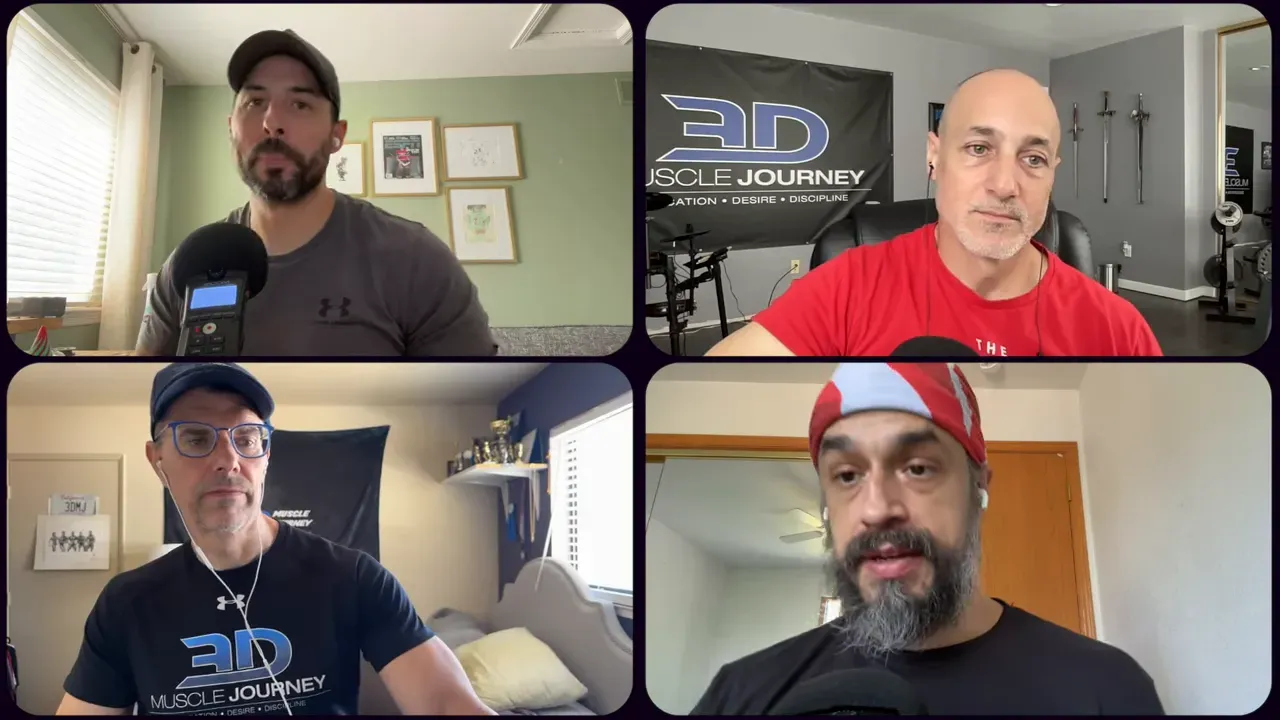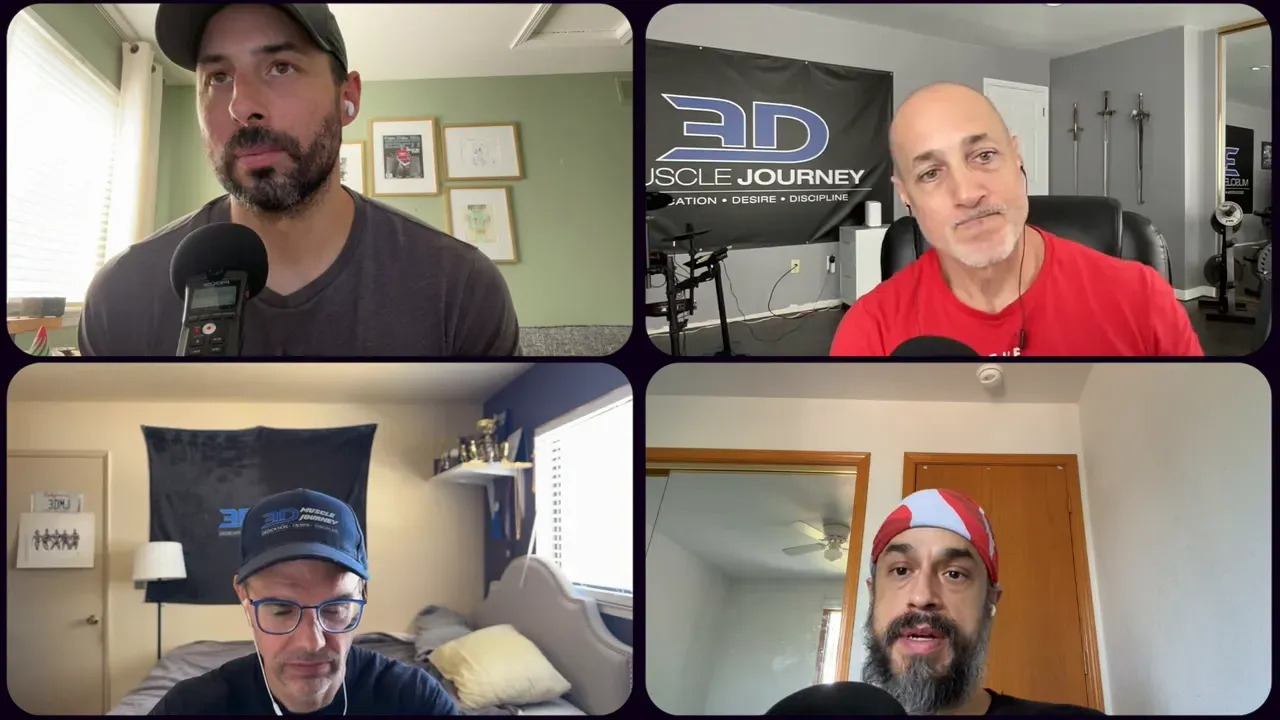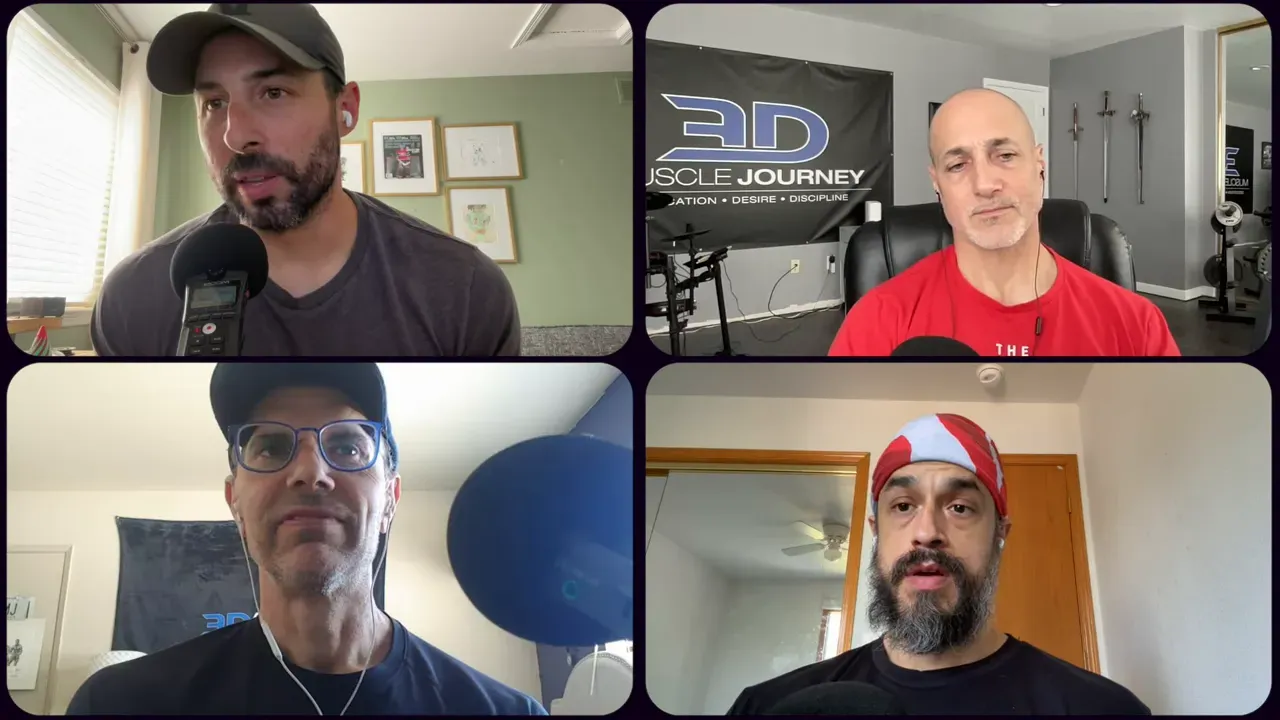Bodybuilding Off-Season: Optimizing Muscle & Recovery
Build more muscle and protect your progress with proven off-season strategies you can use today.

Key takeaways
- You must fully recover after contest prep before pushing major training volume or intensity.
- You can gain useful muscle on modest surpluses: aim for small, steady increases (1–3 lb/month).
- You should prioritize weak body parts with focused tools, frequency, and quality execution.
Try this today
✔️ Take one full week with reduced training and prioritize sleep, appetite, and mood tracking.
Want to gain more muscle while losing less time to wasted cycles?
In this expert review, we analyze, critique, and expand on Team3DMJ's discussion about setting up an optimal off-season plan. We break down the coaching choices the hosts make and translate them into practical steps you can use.
What makes this review different?
- Carefully reviewed and fact-checked by experts with coaching experience.
- Little-known tips to manage rate of gain and preserve training momentum.
- Complete workout plan inspired by prioritizing recovery and focused stimulus.
Why should you listen to us? We've published 300+ articles, all scientifically reviewed by an exercise scientist with 25+ years of lifting and coaching experience.
If you want a clear path out of contest prep into a productive off-season, keep reading. This article gives you the what, why, and how. You’ll get a plan to follow and mistakes to avoid.
Related:
- How often to train for hypertrophy
- How fast you should aim to gain muscle
- How to build muscle: practical, evidence-based guide
In a Nutshell: Optimizing your off-season
You must let recovery finish before you chase growth. That means eating enough, sleeping, and lowering training stress when needed. You get more from food and quality than from immediately adding training days.
Your off-season must be strategic. Pick weak points after a show. Assign priority. Use frequency and tool selection to win. Track performance and keep the experiment simple.
Be patient. Small steady gains beat chaotic, big bulks that hide progress under fat gain. Use food to enable training. Use training to convert that food into muscle.
Key concepts
- Recovery-first: Recovery is prerequisite to meaningful muscle gain after prep.
- Permissive environment: A maintained, small surplus and steady workload let growth occur without excessive fat.
- Priority-based programming: Target weak parts with the right exercises, frequency, and quality before increasing volume.
Start with recovery: why you can’t rush the off-season
Recover before you ramp
The single most repeated point is simple. You cannot expect big muscle gains the moment you step off stage. You need to finish the prior project. That last block of recovery is non-negotiable.

Contest prep is a low-fuel, high-stress state. Your hormones, glycogen stores, and appetite control are out of balance. Your nervous system is taxed. Your connective tissue may be tight. The moment you increase calories, your body will need time to rebuild the capacity to adapt.
What does that mean practically? It means you resist the urge to immediately switch from a 4-day plan to a 6-day, high-volume plan the week after your last show. Many athletes try that. They feel fired up, then burn out again. That costs progress.
How long should you wait?
The coaches generally recommend a sensible progression. Give yourself at least 2–6 weeks of focused recovery.
- Week 0–2: Reduce training frequency and intensity. Prioritize sleep and protein. Keep sessions short.
- Week 2–6: Allow calories to increase gradually. Monitor strength, sleep, and hunger. Reintroduce more frequent work as recovery metrics improve.
- Week 6+: If performance is rising and you feel mentally ready, increase volume or specialize on weak parts.
Most coaches in the conversation say: keep the workload similar to late-prep levels early in the off-season. The extra fuel will boost performance on that baseline. You get more volume indirectly thanks to stronger reps and heavier loads, without adding workouts that amplify fatigue.
Signs you’re recovered and ready to progress
- Performance: you can lift heavier or do more reps at previous loads.
- Appetite: hunger stabilizes and does not spike into chronic overconsumption.
- Sleep and mood: you fall asleep easier and feel less irritable.
- Consistency: you can hit planned sessions without dread.
When training feels like a burden: psychological recovery strategies
It’s normal to feel burnt out
You worked hard for months or years. You poured mental and emotional energy into making stage condition. When it’s over, you can be mentally empty. That’s normal and expected.
Many athletes report feeling “done” with training or that sessions feel like chores. The coaches recommend acceptance and a plan.
Practical approaches
- Drop training days for a short block. Move 5 days to 3–4 days for 1–4 weeks.
- Make the gym fun. For 1–3 weeks, train whatever makes you want to go. No spreadsheets. Just movement.
- Use short maintenance sessions. Do enough to keep muscle and technique intact without draining you.
- Reconnect with life. Spend energy on family, hobbies, and sleep. That replenishes your batteries.
One coach asks athletes to treat the first gym sessions as play. Go lift things that feel cool. Try a new machine. It resets motivation. After 2–3 weeks, convert that fun back into structure and a bridge program.
Assess the season: how to decide what to chase in the off-season
You need clarity before you plan
Don’t start a long off-season program until you have a list of priorities. After a show you gain perspective. You see how you compare to other athletes. That clarity tells you where to invest your energy.

Start with a simple inventory. List body parts and aspects of performance:
- Posing and presentation
- Conditioning and ability to diet
- Muscle groups: quads, hamstrings, lats, front delts, side delts, arms, glutes
- Strength and weak lifts
Put the highest-priority items on top. These are the things you will structure your split around.
Choose constraints first
Before you pick a split, decide how many days per week you can train and what days must be free. Use those constraints to design a split that places your priority body parts where they will get the best stimulus.
Example: If you train 4 days per week and shoulders need work, you can hit shoulders twice with pressing and lateral work rather than burying them after heavy backs and chests.
Programming levers: frequency, volume, and exercise selection
Pick the right lever for the job
There are three primary levers you can pull to bring up a body part: frequency, volume (sets), and exercise selection. You must match the lever to the body part and your recovery ability.
- Frequency: hit a muscle 2+ times per week for most people to accumulate quality sets and reinforce technique.
- Volume: add sets slowly. Track performance and stop when progress stalls or recovery drops.
- Exercise selection: choose tools that let you stress the target muscle well and safely. For shoulders, an overhead press might outpace lateral raises for many lifters.
Order and focus matter
Exercise order shapes how well you can stimulate a target muscle. If biceps are a priority, don’t bury them after heavy rows. Put an arm-specialized session or an early biceps sequence where you can bring the best effort.
Also consider the "focus element." Doing a muscle first helps you mentally direct tension. You’re more likely to hit true effort when you’re fresh and purposeful.
Exercise selection: pick tools that produce consistent, quality reps
Start with what you enjoy, then tighten execution
Enjoyment matters. If a lifter loves a movement, they will do it consistently. Start there. But quality control is the second step. Slow eccentrics, good mind-muscle connection, and honest execution convert fun into results.
Example: You may hate chest-supported rows. But if you refine technique and tempo, they become powerful tools for lat development. Don’t skip the technical work.
Experiment, then commit
Try a tool for at least 8–12 weeks. Track performance on sets and rep ranges. If it moves, stay the course. Avoid constant shifting between “shiny object” exercises.
Managing the rate of gain: why slower often wins
Big bulks hide what matters
Many lifters assume bigger surpluses always lead to more muscle. That is not strictly true for natural bodybuilders. The more advanced you are, the smaller the surplus needed to be productive.

For late-intermediate to early-advanced athletes, a realistic target is 1–3 lb of muscle over several months. This sounds small. It matters. Three pounds of muscle in the right spot changes lines and stage presence more than a 30 lb random bulk ever will.
Practical rate of gain guidance
- Beginner: 1–1.5% body weight per month
- Intermediate: 0.5–1% body weight per month
- Advanced: 0.25–0.5% body weight per month
Track the rate of weight gain. If weight climbs fast and performance does not, slow the gain. If performance and recovery metrics rise with modest weight gain, keep the pace.
Find your off-season body weight sweet spot
Experiment within a narrow range
Find a comfortable weight where you feel strong, energetic, and not overly hungry or lethargic. This is your “permissive environment.” Stay there and milk it. Move 3–5 lb up or down to test whether strength and visual changes follow.
Many experienced competitors hover 10–20 lb above stage weight and remain productive for years. The key is avoiding extreme swings that make the next prep longer and harsher.
What to do if you’ve gained “too much” fat
Here’s the truth: the gym helps now
If you gained more body fat than intended, that’s exactly when you should get back to the gym. Use the higher energy to train with intent. Train heavy and maintain muscle while you plan a conservative fat loss phase.
Many coaches hate unnecessary mini-cuts. If training momentum and performance are high, don’t derail that with an early diet. If fat rises to an uncomfortable or unhealthy point, then plan a controlled, conservative cut later when you can afford to reduce training stress.
Off-season programming: a sample bridge plan
This program is based on the main insight from the discussion: prioritize recovery, then prioritize weak parts with frequency and quality before adding volume.
Program overview
- Ideal for: athletes fresh off contest prep who need a recovery-to-build bridge.
- Equipment needed: barbell, dumbbells up to heavy, cables, leg machine, squat rack.
- Duration: 8–12 weeks as a bridge to a more aggressive mass phase.
Weekly layout (4 days)
- Day 1 – Upper A (priority: shoulders/chest)
- Day 2 – Lower A (priority: quads/glutes)
- Day 3 – Upper B (priority: back/arms)
- Day 4 – Lower B (priority: hamstrings/glutes)
Upper A — Example session
- Heavy compound: Barbell bench press — 3 sets of 4–6 reps
- Shoulder strength: Single-arm DB overhead press — 4 sets of 6–8 reps
- Lateral emphasis: DB side raise — 3 sets of 10–15 reps
- Chest volume: Incline DB press — 3 sets of 8–12 reps
- Accessory: Triceps overhead extensions — 3 sets of 10–15 reps
Pro tips: Use controlled tempo on eccentrics (2–3 sec). Prioritize the single-arm overhead press if shoulders need growth. Keep rest 90–120s on heavy sets; 60–90s on accessory work.
Lower A — Example session
- Compound: Back squat or safety-bar squat — 3 sets of 5–8 reps
- Quad isolation: Leg extensions — 3 sets of 10–15 reps
- Glute focus: Bulgarian split squat — 3 sets of 8–12 reps
- Finish: Walking lunges — 2 sets of 12–16 steps
Pro tips: Prioritize loading that lets you progress weight or reps weekly. If knees resist heavy squats, swap for split squats and heavy leg press.
Upper B — Example session
- Heavy compound: Weighted pull-ups or lat pulldown — 3 sets of 4–6 reps
- Row variation: Chest-supported row — 4 sets of 6–10 reps
- Biceps focus: Barbell curl or heavy DB curl — 3 sets of 6–10 reps
- Rear delts / traps: Face pulls — 3 sets of 12–20 reps
Pro tips: If biceps are a priority, place curls earlier or add a short arm cluster at end. Use full range on lat work and controlled negatives on rows.
Lower B — Example session
- Hip hinge: Romanian deadlift — 3 sets of 6–10 reps
- Hamstring emphasis: Lying leg curl — 3 sets of 8–12 reps
- Glute drive: Hip thrust — 4 sets of 6–10 reps
- Accessory: Calf raises and core — 3 sets each
Pro tips: Use heavier hip thrusts for glute growth. Keep eccentric control on RDLs. Track set loading week to week.
Notes on program execution
- Keep the first 2–4 weeks conservative. Build confidence and mechanics.
- Track volume via weekly hard sets for each muscle group. If performance rises, maintain or slowly add sets.
- Monitor recovery: sleep, HRV if available, hunger, and mood.
- Prioritize protein (1.6–2.2 g/kg). Stay hydrated and slowly increase calories into a small surplus or maintainer depending on goals.
Two closing paragraphs: Start with recovery. Then focus. The off-season is a long game. Small, consistent wins compound. You don’t need to go wild on calories to grow. You need a permissive environment, a prioritized plan, and honest effort.
Want to automate workouts like that and more? Put your progress on autopilot with Dr. Muscle AI. Try it free: https://dr-muscle.com/discount/
Expert Corner: Proven strategies & hidden gems
Practical Applications
- Use a 2–6 week recovery block after contest prep: reduce training volume by 20–50% and monitor performance weekly.
- Prioritize one to two weak body parts for 8–12 weeks with slightly higher frequency (2x/week) and focused tools.
- Control rate of gain: aim for 0.25–1% body weight/month depending on experience to maximize lean mass vs fat gain.
Examples:
- Example 1: If you weigh 180 lb and are intermediate, aim for about 0.5–1 lb gain per month. Track lifts and stop the surplus if strength stalls.
- Example 2: If shoulders lag, schedule a shoulder-focused upper day and a second shoulder volume sequence on an upper/lower split. Progress load on the single-arm DB press over 12 weeks.
Fact-Check of Key Points
"the more advanced you become, the smaller the degree of surplus you can really benefit from"
Fact-check: This aligns with practical experience and physiology—diminishing returns occur as training age increases. Lower surpluses reduce fat gain and extend the permissive environment.
"3 lb is still quite a bit especially when we already have a nice space there"
Fact-check: Small absolute increases in lean mass yield visible changes. For many athletes, a few pounds of muscle in targeted areas alters lines and stage presence.
"just let that food do its work with the the current amount of workload you have"
Fact-check: Increasing energy availability without sharply increasing workload often improves rep quality and volume implicitly. This is a sound tactic.
"you will not make all the gains you want to make until you are fully recovered from that thing."
Fact-check: Recovery improves anabolic responsiveness. After prolonged energy restriction, hormone and performance recovery is necessary before you can reliably gain muscle.
More Little-Known Tips for a productive off-season
- Backload calories if appetite is low early in the day. It helps maintain meal compliance while you stabilize energy.
- Use “bridge programs” for 4–12 weeks that slowly convert fun training back into structured, progressive overload.
- Track hard-set volume per muscle per week rather than workouts alone. That gives a clearer picture of stimulus.
Common Mistakes With Off-Season & How to Fix Them
- Mistake: Immediately increasing training days and volume. Fix: Wait until recovery metrics improve before adding significant work.
- Mistake: Big, fast bulks that require long preps to reverse. Fix: Use smaller, controlled surpluses and prioritize performance metrics.
- Mistake: Chasing every new exercise and changing tools often. Fix: Pick effective tools, refine technique, and commit for at least 8–12 weeks.
My opinion on optimizing your off-season
I believe the off-season is where careers are made. The prep sharpens. The off-season builds. I favor a recovery-first approach. You must let the nervous system and endocrine system reset. If you skip this, you buy back time in the next prep.
I also think smaller, disciplined gains beat reckless bulks. You will look better on stage if you add 3 lb of muscle in the right places and keep tight conditioning control. A measured approach saves months of corrective dieting later.
I disagree with the idea that everyone must get massively heavier to add muscle. That works sometimes for very young, inexperienced lifters. For seasoned athletes, it is wasteful. It increases prep time and risks compounding fatigue.
Finally, I value the mental side. If you are burned out, reduce training and refocus on life. That recharge improves coaching adherence later. Recovery is not laziness; it is strategy.
Concluding on the off-season
A common misconception is that you must immediately “go hard” after a show. That leads to injuries, stalled progress, and frustration. The insider truth is the opposite: slow your roll, regain function, then build with purpose.
Plan backwards from your next show date. Map recovery, a permissive surplus phase, and a focused mass phase. Prioritize weak parts and use frequency and quality as primary levers. Track performance and be patient.
The most valuable months are the months you keep. Small, consistent training with a modest surplus compounds into significant aesthetic and strength changes over 2–3 years. Competitors who understand this have longer, better careers.
Want an automated tool that helps you apply these principles every week? Dr. Muscle AI can build and tweak your program, manage progression, and keep the math tidy. Try it free.
FAQ
How long should I recover after a contest prep?
Recover for at least 2–6 weeks with reduced volume and intensity. Use that time to normalize appetite, improve sleep, and monitor strength; only add substantial new workload once performance and mood consistently improve.
Should I increase training volume immediately after my final show?
No. Keep volume similar or lower for a short recovery phase. The extra calories will raise performance on your existing workload. Increase training volume only after you see reliable gains in strength and recovery metrics.
How much weight should I aim to gain in the off-season?
Aim for modest, controlled gains. Beginners can push faster (around 1% body weight/month). Intermediates should aim for ~0.5–1 lb/month. Advanced lifters should target ~0.25–0.5% body weight/month to maximize lean mass vs fat gain.
Which is more important: frequency or volume for weak body parts?
Both matter, but frequency often gives higher returns with lower per-session fatigue. Hit priority muscles about twice a week while accumulating sufficient weekly hard sets. Adjust volume only after tracking performance trends.
How do I choose exercises for the off-season?
Start with movements you enjoy and can execute well. Prioritize tools that place the most tension on the target muscle safely. Master execution and tempo first, then add sets or shifts in frequency if progress stalls.
When should I cut if I gained too much fat?
Only cut when training momentum or health metrics suffer, or when your timeline requires it. Prefer conservative cuts that preserve training intensity. Avoid repeated mini-cuts that break progress and morale.
Can I still make muscle gains without a large calorie surplus?
Yes. Many lifters make appreciable gains with small surpluses or even near maintenance if recovery and training quality are high. The key is progressive overload and protein adequacy rather than huge calorie surpluses.
How do I measure recovery effectively?
Track subjective markers (sleep quality, mood, energy), objective performance (weekly best reps/loads), and body measures (steady weight trends). If strength and mood rise with steady or small weight increases, you’re recovering well.
Final note
Recover first. Prioritize quality training next. Keep gains steady. If you want a tool that helps automate this process—building programs that adapt to your recovery and progress—check out Dr. Muscle AI.
We used AI to summarize the video 3DMJ Podcast #291: Optimizing Your Off-Season while drafting this expert review.

